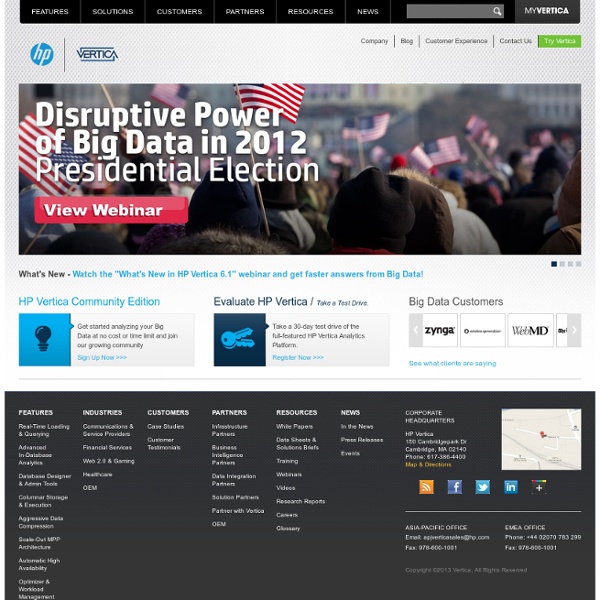



Building data startups: Fast, big, and focused This is a written follow-up to a talk presented at a recent Strata online event. A new breed of startup is emerging, built to take advantage of the rising tides of data across a variety of verticals and the maturing ecosystem of tools for its large-scale analysis. These are data startups, and they are the sumo wrestlers on the startup stage. The weight of data is a source of their competitive advantage. But like their sumo mentors, size alone is not enough. The most successful of data startups must be fast (with data), big (with analytics), and focused (with services). Setting the stage: The attack of the exponentials The question of why this style of startup is arising today, versus a decade ago, owes to a confluence of forces that I call the Attack of the Exponentials. At the same time, these technological forces are not symmetric: CPU and storage costs have fallen faster than that of network and disk IO. Leveraging the big data stack Fast data Big analytics Focused services Related:
Prism Compared | To In-Memory, OLAP, Open Source, Excel, Hadoop, RDBMS It seems that there is no shortage of business intelligence vendors out there. They all claim to be powerful, easy-to-use, flexible and affordable. So how do you pick the one that is right for you? Below is a brief description of how SiSense stacks up against the alternatives. They say seeing is believing, so: REGISTER FOR A LIVE WEBINAR Traditional enterprise BI stacks are provided by companies such as Oracle, SAP, IBM, Microsoft. The SiSense Advantage: With a cutting-edge database technology with data visualization tools and a flexible product architecture, SiSense lets you benefit from the advantages of having a single source of truth, coupled with blazing-fast multi-dimensional analytics, without the complexities of traditional data warehousing and OLAP modeling. Need a detailed comparison? In-memory data discovery tools are known for their ability to perform fast calculations. Need a detailed comparison? Need a detailed comparison? Need a detailed comparison?
AMPLab - UC Berkeley SAS takes aim at SAP with in-memory analytics - Page 1 - Information Architecture SAN FRANCISCO – When is in-memory analytics not really in-memory analytics? According to business intelligence software vendor SAS Institute, when it’s delivered via an in-memory database instead of an in-memory server. SAS took the wraps off several high-performance analytics products leveraging in-memory computing at its annual SAS Executive Forum conference, and took pains to differentiate its offerings from those of rivals such as German business software vendor SAP AG, which is already in the in-memory analytics game with its HANA appliance and data centre offerings. Jim Davis, SAS senior VP (Photo by Jeff Jedras) “There’s not a company out there that doesn’t say they have in memory analytics and a really nice user interface, but they’re not all the same,” said Jim Davis, SAS senior vice-president and CMO. The difference is in the in-memory technology, said Davis. “SAP will sell HANA to lots of current SAP customers. “Visual analytics is really important. Related Download
Innovation et Entrepreneuriat Numériques en France BIG DATA (1/3) Mais bordel c’est quoi la Big Data !2011 a vu l’avènement de la communication M2M, de l’internet des objets ou encore de l’impression 3D. En 2012, on nous a principalement vendu le concept de BYOD (Bring Your Own Device at work pour les novices) et la… big data : discipline naissante ? buzz trendy véhiculé par éminents et respectables journalistes de la trempe de Morandini ou Pernault ? Décryptage. En quelques mots, c’est quoi la big data ? Allez, zou, on commence. 1er commandement : où et quand a commencé le big data ? Okapi et Sciences et Vie Junior ne nous aideront pas sur ce coup-là. Constat simple, face à quelques dizaine de téraoctets, les systèmes d’indexation existants étaient révolus. Avantage non négligeable, ces différentes associations permettent une montée en charge et une extension graduelle d’ordre de grandeur (traduite concrètement par le volume brusque et croissant de données à traiter) tout en maintenant des capacités de calcul égales.
In-Memory Analytics | ActivePivot RESEARCH | Global Pulse In collaboration with UN partners and public sector institutions, Global Pulse identifies problems that could be addressed through real-time monitoring of digital data. Following this, Global Pulse designs and conducts applied research projects. The projects aim to discover practical uses of Big Data to solve these challenges and prototype technology tools for monitoring development progress and tracking emerging vulnerabilities. The framework for joint innovation in the Lab moves through a cycle of consultations, project design and partnership engagement (to secure data, tools and expertise), followed by a period of investigation and prototyping. Joint innovation projects provide unmatched opportunities for private sector, UN agencies, government institutions and academia to gain hands-on experience working together to apply Big Data innovations to solve problems.
Experts :